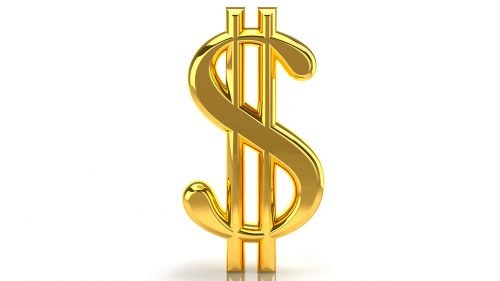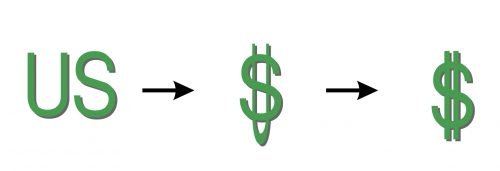The very look of currency symbols casts some light on the history of global trade and power.
Where does the American dollar sign come from?
You can come across several hypotheses about the origins of the dollar sign, which appears to be the most widely used money logo. The best-known theory states it comes from a handwritten abbreviation “PS,” which means “peso” (the “P” was placed over the “S” and lost its curve). According to historians, the oldest use of the dollar sign dates back to the 1770s. It was found in handwritten documents of English-Americans, where they describe their business deals with people of the Spanish-American origins. It was only thirty years later that the “$” sign began to appear in print. The fact that the worth of the Spanish dollar does not differ very much from that of the American dollar seems to support the hypothesis.
Let us introduce other theories, too:
- the “$” sign represents the combination of a “U” and “S” (“The United States” or “units of silver”)
- it comes from the Bohemian thaler depicting a snake on the Christian cross (which is itself a reference to Moses and his pole with a bronze snake around it)
- it was inspired by the so-called Pillars of Hercules flanking the entrance to the Strait of Gibraltar (they could be seen on the Spanish dollar)
The debate about the origins of the dollar money logo has a political aspect. Many people do not like the idea that something that is, in fact, the symbol of the American dream can have roots in another country.
US dollar sign used for other “dollar” currencies
Interestingly, the American dollar symbol has been used to denote the currency of quite a few other countries. In many cases, the currencies have the word “dollar” in their names: the Australian dollar, the Bahamian dollar, the Barbadian dollar, the Bermudian dollar, the Brunei dollar, the Canadian dollar, the Cayman Islands dollar, the Eastern Caribbean dollar, the Hong Kong dollar, and the New Zealand dollar, to name just a few.
In each of the cases, the path to adopting the dollar as a currency and the respective sing was different. And yet, the main reason was always the same: it was either a way to make business deals between countries easier or the result of the pressure from the dominating country (or both).
For instance, let us analyze the history of the Canadian dollar. Before the 1850s, Canada used the pound sterling as its currency. Back then, it was not a decimal system (each pound sterling was divided into 20 shillings and each shilling into 12 pence), which was inconvenient for business dealings with the United States. Eventually, the British government had to agree and grant the Province of Canada the right to use a decimal dollar system.
Many of the “dollar sign” countries mentioned above used to be British colonies. In 1935, the British government introduced the so-called British West Indies Dollar in many of its Caribbean colonies. Interestingly, before that, some of them used the US dollar. After the colonies grew independent, they chose to have their own version of the dollar but left the dollar money logo unchanged.
Dollar sign used for the peso and other currencies
Often, the dollar symbol has been used for the currencies named “peso” (for instance, the Argentine peso, the Chilean peso, the Colombian peso, and Mexican peso), which seems to support the “peso” hypothesis.
Moreover, the sign has been used for several currencies that do not even contain the words “peso” or “dollar”: the Bolivian bolíviano (here, it is used in combination with the letter “b”), the Brazilian real (a serif dollar sign in combination with the “R”), and the Salvadoran colón.










